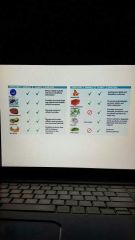![]()
![]()
![]()
Use LEFT and RIGHT arrow keys to navigate between flashcards;
Use UP and DOWN arrow keys to flip the card;
H to show hint;
A reads text to speech;
36 Cards in this Set
- Front
- Back
|
Definition of Chromatin: |
A mass of long, thin fibers consisting of DNA with some proteins attached. |
|
|
Definition of Nucleolus: |
An area near the center of the nucleus where subunits of the ribosomes are assembled. |
|
|
The nucleus is usually the largest and most prominent organelle in the what cell? |
Eukaryotic cell. |
|
|
What does the nucleus direct? |
Most cellular activities by controlling which molecules are produced and in what quantity. |
|
|
What stores hereditary information? |
The Nucleus |
|
|
What are the functions for the cytoskeleton? |
Acts as inner scaffolding of the cell, provides shape and support, controls intracellular traffic flow, enables movement. |
|
|
What are the three types of protein fibers in the cytoskeleton? |
Microtubules, intermediate filamentsn microfilaments |
|
|
What is microtubules? |
Thick hollow tubes, the tracks to which molecules and organelles within the cell may attach and be moved along. |
|
|
What are intermediate filaments? |
Durable, rope-like systems of numerous overlapping proteins, gives cells great strength. |
|
|
What are microfilaments? |
Long, solid rod-like fibers, help with cell contraction and cell division |
|
|
What is the inner scaffolding of a cell? |
The cytoskeleton |
|
|
What is the Mitochondria functions? |
Act as all-purpose energy converters, harvest energy to be used for cellular functions. |
|
|
What are the parts to mitochondria? |
DNA, Matrix, Outer membrane, Inner membrane, intermembrane space |
|
|
Mitochondria have their own what? |
DNA |
|
|
In mitochondria, the energy contained within the chemical within the chemical bonds of carbohydrate, fat, and protein moleculesis converted into what? |
Carbon dioxide, water, and ATP, the energy source for all cellular functions and activities. |
|
|
What are lysosomes? |
Round, membrane-enclosed, acid-filled vesicles that function as garbage disposals. |
|
|
What is a lysosomes function? |
Act as floating garbage disposals for cells, digesting and recycling cellular waste products and consumed material. |
|
|
What are the parts to a lysosome? |
Membrane, digestive enzymes and acid, partially digested organelle |
|
|
What are the three endomembrane systems? |
Rough endoplasmic reticulum, Smooth endoplasmic reticulum, golgi apparatus |
|
|
What are the functions for the endomembrane system? |
Produces and modifies molecules to be exported to otherparts of the organism, breaks down toxic chemicals and cellular by-product |
|
|
What is the Rough Endoplasmic Reticulums function? |
Modifies proteins that will be shipped to other locations in this endomembrane system, the cell surface, or outside the cell. |
|
|
What are the functions for the Smooth ER? |
Synthesizes lipids such as fatty acids, phospholipids, and steroids, detoxifies molecules such as alchohol, drugs, and metabolic waste products. |
|
|
What is the function for the golgi apparatus? |
Processes and packages proteins, lipids, and other molecules for export to other locations inside and outside the cell |
|
|
What is the endomembrane system? |
1) transport vesicle buds from the smooth to the rough ER. 2) Transport vesicle fluses with golgi apparstus, dumping, contents inside. 3) Golgi Apparatus modifies the molecules as they move through its successive chambers. 4) modified molecules bud off from the golgi apparatus in a transport vesicle. 5) Vesicle may fuse with the plasma membrane, dumping contents outside the cell for delivery elsewhere in the organism. |
|
|
The cell wall is found in _____ cells. |
Plant |
|
|
What is a cell wall made of? |
Carbohydrate cellulose, it surrounds the plasma membrane of a plant cell. |
|
|
The cell wall gives strength, .... |
Plants increased water resistance, provides some protection from insectsand animals |
|
|
What is a plasmodesmata? |
Connect cells and enable communication and transport between them. |
|
|
What is the purpose of a vacuole? |
Stores nutrients, retains and degrades waste products, accumulates poisonous materials, contains pigments enabling plants to attract birds and insects to help the plant reproduce, provides physical support |
|
|
The central vacuole plays in what 5 areas of life? |
1. Nutrient storage, 2. Waste management, 3. Predator deterrence, 4. Sexual reproduction, 5. Physical support |
|
|
How big are vacuoles? |
They occupy most of the cells space |
|
|
What is the function for chloroplast? |
Site of photosynthesis, the conversion of light energy into chemical energy. |
|
|
What are the two parts to Chloroplast? |
Stroma, Thylakoids |
|
|
What is Stroma? |
Fluid inside chloroplast |
|
|
What is Thylakoids? |
Interconnected flattened sacs |
|
|
Graph |

|

